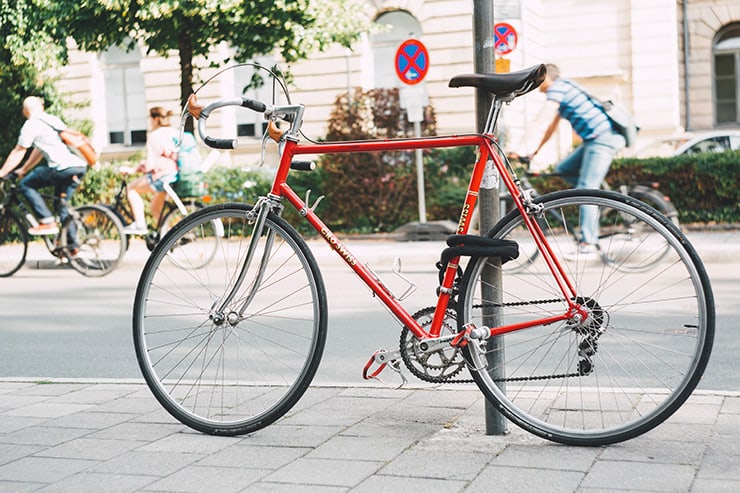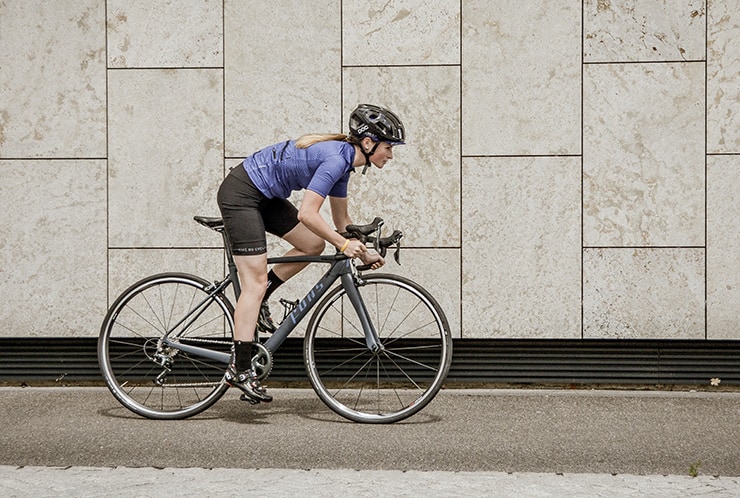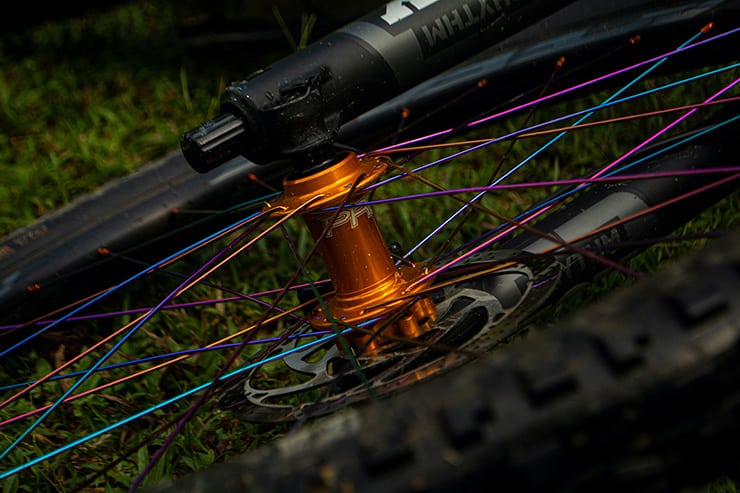The hub plays an important role in the movement of a bicycle, but not many people know how it works or even what it is. Understanding your bicycle helps you take better care of it; so it’ll serve you for longer!
So what is a bike hub and what exactly does it do?
A bike bicycle hub is the part at the center of your wheel that connects to the rim using spokes. It’s small and easy to overlook, but you can’t ride your bike without it.
Learn all about bike hubs–their function, the different types of hubs, and how to choose the right hub for your bike– in this handy guide. I’ll also answer the most common questions about bicycle hubs, so read on!
Key Takeaways
- A bike hub is the part at the center of your wheel that connects to the rim using spokes. It allows your wheel to spin freely and smoothly.
- There are different types of bike hubs for different types of bikes and they differ in size, weight, spoke count, and attachment style.
- The rear hub has an extra part called the freehub body, which enables you to coast or stop pedaling without stopping the bike.
- The freehub body can use either a ratchet or a pawl system to disengage the wheel from the hub.
- The quality and maintenance of your bike hubs can affect your cycling performance and experience. You should service them regularly.
What Is the Purpose of a Hub on Your Bike?
As mentioned, bike hubs may be small, but they perform some essential functions. First, hubs hold your bicycle together by connecting the wheels to the bike’s frame. They also allow your wheels to spin freely and smoothly.
Apart from that, every bike has two hubs: the front and rear.
The rear hub is slightly more complex than the front hub. Besides holding the bike together and allowing the wheel to rotate, it also transfers pedaling power to the rear wheel.
In order to best understand the functions of both rear hubs and front hubs, we’ll look at them separately.
But first…
Components of a Bike Hub
The basic parts of a bicycle hub include the hub shell, axle, and bearings.
The hub shell is the outer part of the hub that houses everything and onto which spokes are attached. Some people refer to it as the hub body.
The axle is the part that runs through the shell, protruding on either side, where the frame connects to the wheel.
The bearings reduce friction and allow the shell to rotate smoothly around the axle.
The rear hub also includes a freehub body on the right side. It’s an extended part of the rear hub that the cassette attaches onto.

Front Hub
The front hub, in most bikes, is simple. It has an axle that passes through the hub shell and attaches to the fork. Different manufacturers use different attachment styles, including bolts, nuts, and quick-release.
The front hub also features bearings, which can either be loose ball bearings (also known as cup-and-cone) or cartridge bearings. These bearings allow the bike wheel to rotate around the axle so the bicycle can move.
These parts allow the front hub to connect the wheel to the rest of the frame and enable the wheel to turn.
Rear Hub
The rear hub does the same job as the front hub–connecting the frame to the wheel and allowing the wheel to rotate. But besides that, it helps transfer your pedaling effort to the wheel.
As such, the hub on the rear wheel has the same parts you find on the hub on your front wheel plus extra parts for the additional function.
Most modern bicycles have a freehub body that a sprocket (the toothed wheel with a chain) or cassette (a cluster of sprockets) attaches to. The freehub body can spin independently of the hub shell, making it possible for you to coast.
Do Bike Hubs Affect the Speed of Your Bicycle?
Wheel hubs can make a difference in the performance of your bicycle.
Several parts are involved in the movement of your bike, and both your front and rear hubs are part of this system. If any part is not working properly, it will affect the performance of your bicycle.
We’ve learned about bike components and the roles they play, such as how bearings allow the hub shell to rotate smoothly around the axle. As a result, the wheel will rotate effortlessly. If, however, the bearings create resistance, the wheel will turn slower and lead to a lower cycling speed.
As mentioned, hubs are not the only parts that can create resistance, leading to the loss of power. The chain is the biggest resistance source, followed by the rear derailleur pulleys.
Hubs are much further down the list, so their general effect on performance is quite small.
If you suspect that your hubs are creating more than the normal amount of resistance and slowing you down, just check. Turn your bicycle upside down and try spinning the wheels. They should spin freely. If not, something is wrong and you’ll need to check it out. I’ll discuss this more below.

The Different Types of Hubs
Usually, different types of bikes have different types of wheel hubs. Let’s take a closer look at each one of them.
Road Bike Hubs
One thing that sets different hubs apart is the rear hub spacing. Most modern hubs have a standard spacing of 100 mm at the front. So the difference will be in the rear wheel hub.
Road bikes typically have thinner hubs, 130 mm, and thru-axles than the ones you’ll find on a mountain bike.
However, some road bike frames are designed for disc brakes, and these have a 135 mm hub width.
The hubs are also lighter since road bikes are designed for paved surfaces and competitive cycling. The thinner and lighter hubs make it easier for you to pedal faster and farther.
Road hubs, in many cases, will come with fewer spoke holes. A smaller number of spokes makes the wheel lighter and more aerodynamic. But it also means a weaker wheel because more spokes allow for better weight distribution.
Mountain Bike Hubs
Mountain bikes tend to have thicker rear hubs, usually 135 mm wide. This allows more room for attaching disc brakes. Their thru-axle is also thicker, a feature that gives you better control of the bicycle on tough trails.
Boost hubs can be even wider, 110 mm for front hubs and 141 mm for rear hubs.
Mountain bikes are meant for rough terrain, so it makes sense that MTB hubs are heavier and sturdier; they can handle impact without getting damaged.
So while mountain bike hubs are tough and sturdy to ensure they can handle impact, road bike hubs are thinner and lighter for speed and efficiency.
Mountain bike hubs have more spoke holes than road hubs because they tend to have a higher spoken count. They can handle more weight and stress better.
BMX Hubs
Like mountain and road hubs, the spacing in the front BMX hubs is 100 mm. The rear hub is 110 mm–a significant difference from the other hubs.
BMX hubs have the highest number of spoke holes of these three types of hubs. BMX wheels have a much higher spoke count, usually 36. The advantage of having a high spoke count, as mentioned, is that a wheel can bear more weight and stress.
What Is a Freehub?
I have touched on the freehub above. It’s a small part that can be complex and hard to understand for most people.
The freehub body on your rear wheel hub has a small extended part on the right side. It allows you to coast or continue moving even after you have stopped pedaling by disengaging the wheel.
Most manufacturers use one of two freehub systems–ratchet or pawl to make this possible.
Freehubs also have their own bearings to help them turn, which can be a cartridge or loose ball bearings.
So what’s the difference between a freehub and a freewheel?
A freewheel is not an extension of the wheel hub like a freehub. Instead, it is incorporated into the cassette and screws onto the hub. The two are not interchangeable.
The freewheel is what came before the freehub so you’ll mainly see it on much older models, cheaper modern bikes, and children’s bikes.
In many (not all) cases, freewheels are the better budget option while freehubs are higher quality and more durable.
What to Consider When Choosing a Bike Hub
One of the factors to consider when choosing a hub for your bike is the weight.
Hub weight will affect your cycling experience. For instance, a heavy bike hub increases the unsprung mass or unsprung weight on mountain bikes and other bikes with suspension. As a result, the suspension will react slower to changes in the terrain, making for a less comfortable ride.
On a road bike, a heavier bicycle hub could reduce your bike’s speed and make it harder to handle.
When choosing a lighter hub, ensure you’re not settling for a cheaper one that won’t last.
The quality of bearings is another factor that you shouldn’t ignore. High-quality bearings are more durable. They can also run more smoothly and reduce drag.
Lastly, make sure that the bicycle hub is compatible with your bike frame. You have seen that different bikes have different hub spacings and not every market hub will suit your bike.
Bike Hub Maintenance
Proper maintenance of your hubs–and other bicycle parts–will ensure that the whole system is working well. You will enjoy more years of amazing cycling experiences.
If your wheels are not spinning as freely as they should, it’s time to service your hubs. Turn your bike over and spin the wheels. The rotation of the wheel should be effortless.
Here is a video explaining, in great detail, how to service your hub bearings.
Frequently Asked Questions About Bike Hubs
Do Bike Hubs Make a Difference?
Yes, bike hubs make a difference. They may seem like small parts but they play a key role in how your wheel rotates and affect your ride’s quality and your enjoyment too! This is why you must always ensure that your hubs are in good condition.
How Do I Know If My Hubs Are Good?
Your hubs are good if the wheels turn freely and don’t feel stiff. You can use the simple test I have discussed above–turning the bike over and spinning the wheels.
What Are the Components of a Bicycle Hub?
A bicycle hub is made of a hub shell or body, bearings, and an axle. These are the basic parts of a typical bike hub.
Are Expensive Bike Hubs Worth It?
This depends on how much you’re paying and what you’re paying for. Durable and reliable bike hubs will cost you some money. However, you don’t necessarily need to get high-end hubs. Past a certain price point, you’ll be paying for “innovative features” that may not make a big difference in your riding.
Bottom Line
A bike hub may not be the biggest part of your bike but it’s definitely one of the most important parts. It can also be a little complex.
A bicycle hub comprises three key components–a hub body, axle, and bearings. There are other smaller parts too, depending on the attachment style of the axle. Both the front and rear hubs connect the frame to the wheels and allow the wheel to rotate freely.
The rear hub has the additional role of transferring your pedaling power to the wheel. It, therefore, has an extra part, the freehub body.
There are different types of bike hubs for different kinds of bikes. They include BMX hubs, MTB hubs, and road hubs. The standard front hub width for all these bike types is 100 mm. The difference in size is usually in the rear hubs.
Bicycle hubs make a difference in your riding experience. So you should make sure that, as you maintain other bike parts, you don’t forget about your hubs. If your wheels don’t feel as smooth as they should, it may be time to service your hubs.

